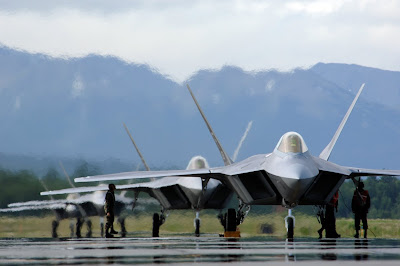(NSI News Source Info) WASHINGTON - June 5, 2009: The U.S. Air Force estimates it would cost Japan as much as $250 million per plane to buy dozens of radar-evading F-22 fighter jets, a U.S. senator told Japan's ambassador in a letter, saying he hopes to reverse a current U.S. ban on such exports.  The F-22's engines produce more thrust than any current fighter engine, especially in military (non-afterburner) power. Called "super cruise," this characteristic allows the F-22 to efficiently cruise at supersonic airspeeds without using afterburners. This capability greatly expands the F-22's operating envelope in both speed and range over current fighters that must use afterburner to operate at supersonic speeds.
The F-22's engines produce more thrust than any current fighter engine, especially in military (non-afterburner) power. Called "super cruise," this characteristic allows the F-22 to efficiently cruise at supersonic airspeeds without using afterburners. This capability greatly expands the F-22's operating envelope in both speed and range over current fighters that must use afterburner to operate at supersonic speeds.
 The F-22's engines produce more thrust than any current fighter engine, especially in military (non-afterburner) power. Called "super cruise," this characteristic allows the F-22 to efficiently cruise at supersonic airspeeds without using afterburners. This capability greatly expands the F-22's operating envelope in both speed and range over current fighters that must use afterburner to operate at supersonic speeds.
The F-22's engines produce more thrust than any current fighter engine, especially in military (non-afterburner) power. Called "super cruise," this characteristic allows the F-22 to efficiently cruise at supersonic airspeeds without using afterburners. This capability greatly expands the F-22's operating envelope in both speed and range over current fighters that must use afterburner to operate at supersonic speeds.The F-22 has been extensively designed, tested and refined aerodynamically during the demonstration/validation (dem/val) phase and the current Engineering and Manufacturing Development (EMD) phase. The F-22's sophisticated aero-design and high thrust-to-weight ratio provide the capability to outmaneuver all current and projected threat aircraft. To ensure the F-22 provides air dominance for deep-interdiction aircraft, it operates at medium and high altitude at ranges superior to current generation air dominance aircraft.
To ensure operational flexibility, the F-22 has better reliability and maintainability than any military fighter in history. Increased F-22 reliability and maintainability pays off in less manpower required to fix the aircraft and consequently less airlift required to support a deployed squadron. Additionally, reduced maintenance support provides the benefit of reduced life-cycle cost and the ability to operate more efficiently from prepared or dispersed operating locations.
The above characteristics provide a synergistic effect that ensures F-22 lethality against an advanced air threat. The combination of reduced observability and super cruise drastically shrinks surface-to-air engagement envelopes and minimizes threat capability to engage and shoot the F-22.
The F-22 has a secondary role to attack surface targets. The aircraft will be capable of carrying two 1,000-pound Joint Direct Attack Munitions (JDAMs) internally and will use on-board avionics for navigation and weapons delivery support.Senator Daniel Inouye, who heads the Senate Appropriations Committee, said this price included the cost of creating an export version of the most advanced U.S. fighter, built by Lockheed Martin Corp. This assumes production would begin in four to five years, with deliveries in seven to nine years, according to two sources familiar with the letter.
Rob Blumenthal, a spokesman for Inouye, confirmed the senator had sent letters on the F-22 issue to the ambassador, Ichiro Fujisaki, and to Defense Secretary Robert Gates. He declined to release the letters or discuss their content.
The sources, who asked not to be named since the issue is still far from decided, said the U.S. Air Force had reversed its opposition to F-22 exports after studying the issue of F-22 exports again over the past four to six months.
The estimated cost is far higher than the roughly $150 million paid by the Air Force for its last batch of fighters, but the price tag would come down considerably if Congress decides to add funding for more U.S. F-22s to the fiscal 2010 budget, the sources said.
"That would help quite a bit because it would avert the cost of restarting the production line once it had stopped," said one of the sources.












0 comments:
Post a Comment